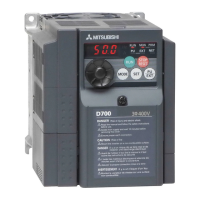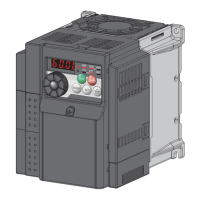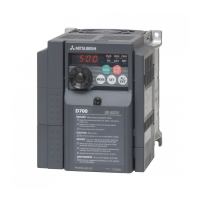What to do if Mitsubishi Electric FR-D720S-1.5K shows PU disconnection?
- Kkenneth37Sep 6, 2025
This function stops the inverter output if communication between the inverter and PU is suspended. Connect the parameter unit cable securely.

What to do if Mitsubishi Electric FR-D720S-1.5K shows PU disconnection?
This function stops the inverter output if communication between the inverter and PU is suspended. Connect the parameter unit cable securely.
What to do if Mitsubishi Electric Inverter has overcurrent trip during acceleration?
If the inverter output current reaches or exceeds approximately 200% of the rated current during acceleration, the protective circuit activates and shuts off the inverter output. You can increase the acceleration time. If "E.OC1" is always lit at starting, disconnect the motor and start the inverter. Check for output short-circuit/ground fault and set 50Hz in Pr. 3 Base frequency.
What causes Mitsubishi Electric FR-D720S-1.5K Inverter overload trip and how to fix it?
The inverter output stops if the temperature of the output transistor element exceeds the protection level when a current not less than the inverter rated current flows and overcurrent trip does not occur (200% or less). To resolve this, increase the acceleration/deceleration time.
What does it mean when my Mitsubishi Electric Inverter shows an inverter overload trip?
An inverter overload trip on your Mitsubishi Electric Inverter means the electronic thermal relay function, which protects the inverter elements, has been activated. To resolve this, try increasing the acceleration/deceleration time, adjusting Pr. 0 Torque boost setting, setting Pr. 14 Load pattern selection appropriately, reducing the load, or ensuring the surrounding air temperature is within the specified limits.
What does output current detection value exceeded mean on Mitsubishi Electric FR-D720S-1.5K Inverter?
This function is activated when the output current exceeds the Pr. 150 Output current detection level setting. Check the settings of Pr. 150 Output current detection level.
What causes a stall prevention (overcurrent) on a Mitsubishi Electric FR-D720S-1.5K and how to fix it?
The overcurrent stall prevention on your Mitsubishi Electric Inverter has been activated. To resolve this: * Increase or decrease the Pr. 0 Torque boost setting by 1% and check the motor status. * Set a larger value in Pr. 7 Acceleration time and Pr. 8 Deceleration time. * Reduce the load weight. * Try General-purpose magnetic flux vector control. * Adjust the Pr. 13 Starting frequency setting. * Change the Pr. 14 Load pattern selection setting. * Set the stall prevention operation current in Pr. 22 Stall prevention operation level.
How to resolve analog input fault on Mitsubishi Electric Inverter?
An analog input fault appears if voltage(current) is input to terminal 4 when the setting in Pr.267 Terminal 4 input selection and the setting of voltage/current input switch are different. Give a frequency command by current input or set Pr. 267 Terminal 4 input selection, and voltage/current input switch to voltage input.
What happens when Mitsubishi Electric FR-D720S-1.5K has output phase loss?
If one of the three phases (U, V, W) on the inverter's output side (load side) is lost during inverter operation, the inverter stops the output. Ensure that the cables are wired properly.
What to do if my Mitsubishi Electric Inverter is showing overcurrent trip during constant speed?
If your Mitsubishi Electric Inverter is showing an overcurrent trip during constant speed operation, make sure the load is stable. Also, check the wiring for any output short circuits or ground faults. Try lowering the stall prevention operation level and activating both the stall prevention operation and the fast-response current limit operation (Pr.156).
What causes regenerative overvoltage trip during constant speed on Mitsubishi Electric FR-D720S-1.5K Inverter?
If regenerative energy causes the inverter's internal main circuit DC voltage to reach or exceed the specified value, the protective circuit is activated to stop the inverter output. Ensure that you keep load stable.
| Model | FR-D720S-1.5K |
|---|---|
| Series | FR-D700 |
| Rated Output Power | 1.5 kW |
| Horsepower | 2 HP |
| Control Method | V/f Control |
| Max Output Frequency | 400 Hz |
| Overload Capacity | 150% for 60 seconds |
| Weight | 1.5 kg |
| Input Frequency | 50/60 Hz |
| Cooling Method | Fan Cooled |
| Input Voltage | 200-240V |
| Output Voltage | 200-240V |
| Output Frequency | 0-400 Hz |
| Protection Features | Overcurrent, Overvoltage, Undervoltage, Overheat |
| Operating Temperature | -10 to +50°C (14 to 122°F) (Non-freezing) |
| Storage Temperature | -20 to +65°C |
Covers essential safety precautions such as wiring, handling offcuts, wiring length, electromagnetic interference, and capacitor discharge.
Explains how to implement interlocks using inverter status output signals to prevent accidents when the inverter fails.
A comprehensive list of all available parameters, including their function, setting range, initial value, and refer to page.
Covers manual torque boost, general-purpose magnetic flux vector control, slip compensation, and stall prevention operations.
Details motor overheat protection, applied motor settings, and offline auto tuning for optimal motor performance.
Covers input and output terminal functions, communication settings, and safety stop functions.
Describes automatic restart after power failure, flying start, and power-failure deceleration stop functions.
Details retry functions, input/output phase loss protection, and earth fault detection at start.
Covers reset selection, disconnected PU detection, parameter write disable, reverse rotation prevention, and password functions.
Details selection of operation modes (PU, External, Network, Combined) and control source switching.
Explains PID control, dancer control, regeneration avoidance, and frequency setting by analog input.
Explains the procedures to reset the inverter after a fault occurs, including using the operation panel, power cycling, or RES signal.
A comprehensive list of error messages, warnings, alarms, and faults displayed on the operation panel, with corresponding names and page references.
Provides detailed causes and troubleshooting steps for various error messages, warnings, and faults.
Offers a systematic approach to diagnosing common issues like motor not starting, abnormal noise, or incorrect speed.












